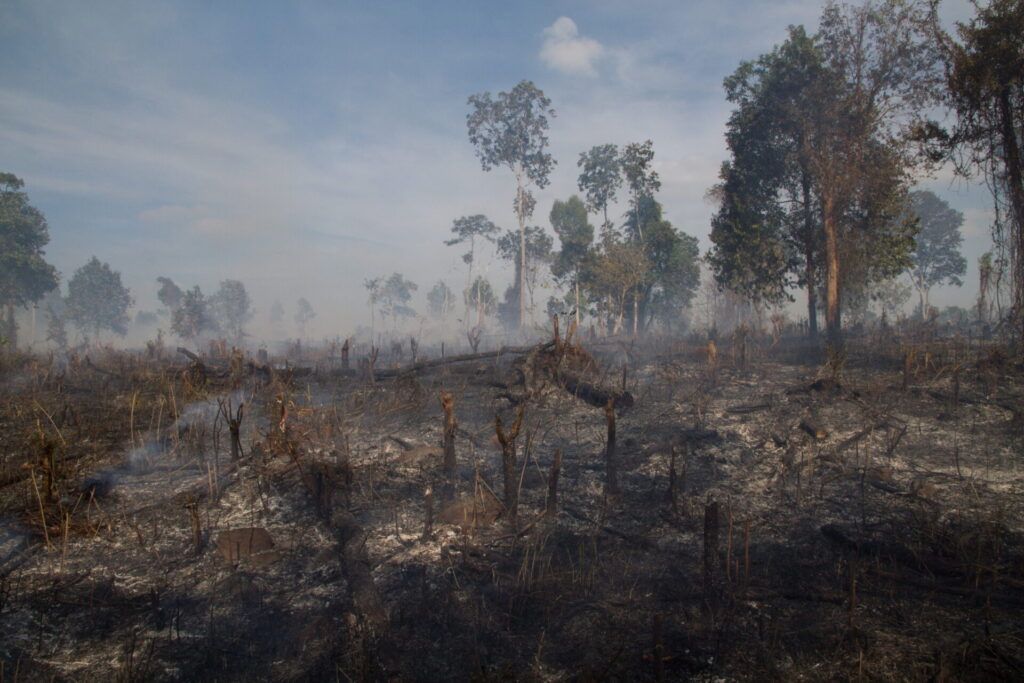Study: Just 6 percent of carbon offsets for curbing deforestation lead to emissions reductions
By Keerti Gopal | August 30, 2023
 Illegal deforestation near Saen Monourom, Mondulkiri Province, Cambodia. Christian Pirkl, CC BY-SA 4.0
Illegal deforestation near Saen Monourom, Mondulkiri Province, Cambodia. Christian Pirkl, CC BY-SA 4.0
Editor’s note: This story was originally published by Inside Climate News. It appears here as part of the Climate Desk collaboration.
Carbon offset projects claiming to curb deforestation are significantly overestimating their impact, according to a new study published in Science last week.
Sold as a way to lessen the impact of greenhouse gas emissions by allowing polluters or consumers to purchase offsets or credits that allow them to keep emitting in return for funding projects that decrease emissions elsewhere, offsets have become a high-profile model for corporate climate action.
But a systematic evaluation of 26 carbon offset projects that claim to slow the rate of potential deforestation in six countries on three continents, found that the vast majority of projects did not actually slow deforestation, and those that did were significantly less effective than they claimed.
“The main message is that relying on [carbon offset] certification is not enough,” said the study’s lead author, Thales West, an interdisciplinary ecologist and assistant professor at Vrije Universiteit in Amsterdam and a fellow at Cambridge’s Centre for Environment, Energy and Natural Resources. “If you rely 100 percent on offsets, you probably will not do anything positive in terms of mitigating climate change.”
The study focuses on voluntary REDD+, or Reducing Emissions from Deforestation and forest Degradation projects. These are standalone projects that operate independently in the voluntary carbon offset market, outside of the United Nations Framework Convention on Climate Change’s REDD+ framework for national and subnational projects.The authors call for “urgent revisions” to the certification methods used to attribute avoided deforestation to these projects, pointing out major flaws in current practice.
Over the past few decades, carbon offsets have become increasingly ubiquitous, particularly in higher-income countries, where consumers can assuage their climate guilt by paying a little extra for a flight ticket or a rental car, with the understanding that their additional payment will go towards supporting a tree farm, for example. Big, high-emitting companies like Delta, JetBlue, Disney, General Motors and Shell have all bought and sold huge amounts of carbon offsets in the name of climate action. It’s an attractive business model for companies looking to “go green” without significant changes in their operations: purchase some carbon offsets to cancel out your emissions. Or, at least, appear to.
Ever since carbon offsets hit the market, there’s been significant debate over whether or not they’re an effective model for climate mitigation. The Cambridge study illustrates a basic problem: many carbon offsets aimed at reducing deforestation are not nearly as effective as they claim to be. And in a lot of cases, they may not be doing anything at all.
Julia Jones, a Ph.D. conservation scientist at Bangor University focused on conservation impact evaluation,said the study’s unique methods make it especially compelling and set it apart from other research in the field.
“Their study is definitely the largest in scope and using pretty much the most robust methods at the moment,” said Jones, who was not involved in the study.
The study looked at 26 projects in six countries: Cambodia, Colombia, Democratic Republic of Congo, Peru, Tanzania and Zambia. Researchers found that only eight of the 26 projects selling offsets showed any evidence of reducing deforestation, and even those that did failed to achieve the extent of reductions that the projects claimed.
Only 18 of the 26 projects had sufficient publicly available information to determine the number of offsets they were projected to produce. From project implementation until 2020, those 18 projects were expected to generate up to 89 million carbon offsets to be sold in the global carbon market. But researchers estimate that only 5.4 million of the 89 million, or 6.1 percent, would be associated with actual carbon emission reductions.
West said companies that are buying and selling carbon offsets that have been certified by third party entities may not be aware that they’re misleading their customers—they might simply trust that the certification is legitimate. But the processes used to evaluate the projects’ effectiveness for certification are deeply flawed, he said.
Most projects look at historical deforestation within a region to forecast a baseline deforestation rate, or the amount of deforestation that would have happened without the project’s intervention, West said. The problem is, it’s all based on hypotheticals.
“They’re not really doing good science,” he said.
West and his colleagues took a different approach. They created a weighted average of regions that are similar to the project area but don’t house any projects, and used that as a “synthetic control.” Then, they compared deforestation in the synthetic control areas with the project areas during the period of time that the project was active. If projects are successfully reducing deforestation, then those project areas should exhibit less deforestation than the synthetic controls. Instead, West and his colleagues found that usually wasn’t the case.
Jones emphasized that the takeaway from the study is that there needs to be increased investment in effective projects for deforestation reduction, not a disinvestment in forest protection. The voluntary carbon market has become a crucial source of funding for forest conservation initiatives, she said, and this funding needs to continue.
“We simply cannot tackle climate change without stopping both tropical forest deforestation and forest degradation now,” Jones said. “It’s a real urgent priority.”
Still, Jones added that overall, carbon offsets have a limited capacity for tackling climate change. Drastically reducing emissions is imperative for climate mitigation, while carbon offsets can have the negative impact of giving people moral license to continue business-as-usual emissions, she said, with companies problematically claiming “net zero” emissions based on carbon offset programs while continuing to emit greenhouse gasses.
Reducing deforestation is critical for combating climate change, as is reducing emissions, so a model that trades one for the other won’t be wholly effective, Jones said. Offsetting does not reduce the need for urgent climate actions like the minimization of emissions, forest restoration and remediation, and conservation, she said.
“[Carbon] offsetting can only ever be for those final, unavoidable emissions or the unavoidable biodiversity loss,” Jones said.
Alistair Jump, a Ph.D. global change ecologist at the University of Stirling with a focus on climate change, said that although there are some impactful local projects funded by carbon offsets, he has low-confidence in the efficacy of most projects and is highly skeptical of the carbon offset model overall.
“The ultimate thing that we need to be doing here is keeping fossil fuels in the ground,” Jump said.
Andreas Kontoleon, a Ph.D. lead researcher on the Cambridge study, said he’s not ideologically opposed to carbon offsets, but said they need to be more accurately monitored.
The researchers are “raising the alarm that we need to fix this market,” Kontoleon said, adding that the study echoes other research from the past few years that points toward a need for tightened protocols on carbon offset project certification.
A preprint of the study earlier this year, included in an investigation into carbon offsets published by The Guardian, garnered criticism from the carbon offset industry, including the world’s leading carbon offset certifier, Verra. In response to The Guardian, the nonprofit questioned the use of “synthetic controls” and claimed studies were miscalculating the impact of REDD+ projects.
Jones said that critiques of the synthetic control method reflect an incomplete understanding of the science, noting that this approach offers more information about deforestation for analysis than the typical “ex ante” method, which relies on hypothetical forecasts rather than actual observed data.
West said that the research team did find one piece of industry feedback valuable: Verra criticized the study’s use of a particular University of Maryland dataset mapping annual global deforestation from 2001 to 2020. In 2011, the University of Maryland improved its data collection methods, and Verra argued that the authors should have accounted for this change in methodology.
In response, West said he and his team investigated the data to account for the 2011 methods change, and removed a few control areas that may have been impacted, though he said the data removed was not necessarily problematic.
West said this change did not impact the study’s results and instead strengthened the conclusion that these carbon offset projects were not as effective as they claimed.
“We basically gave the projects all the chances we could for them to work but, still, even taking that approach, they still didn’t work,” West said.
In a statement responding to the updated paper, Verra said it welcomes scientific insights but maintains its original critiques of the study.
“Our initial analysis of this version indicates that, despite some minor changes, the overall methodology, results and conclusions are the same—and, therefore, the significant concerns we flagged earlier this year still hold,” the statement read.
Verra said, however, that it recognizes the need for improvements and is working on a new consolidated REDD+ methodology, to be released later this year.
Arun Agrawal, a Ph.D. political scientist at the University of Michigan who studies international development and environmental conservation, said the study was very well done, but argued that the researchers’ conclusions were limited and did not sufficiently address impacts on local and Indigenous communities located near deforestation avoidance projects.
Agrawal, who was not involved in the study, said the researchers’ conclusion—that more rigorous methodologies are needed to assess deforestation avoidance from carbon offset programs worldwide—is accurate. But he said that the whole REDD+ structure and offset model needs to be questioned more deeply.
“I believe carbon offset projects such as REDD+ are fundamentally misguided,” Agrawal said.
Agrawal said most of these projects fail to give adequate ownership to the Indigenous communities that have rights to these forested lands. At the end of the paper, the authors recommended increased attention to local communities. Agrawal said recognition of the impacts on local communities is only the first step. He argued that REDD+ projects aimed at preserving forests cannot succeed unless Indigenous groups and local communities are equally involved in analysis, implementation and decision making processes about mitigation projects.
Agrawal also pointed to a lack of permanent sequestration as one major problem with deforestation reduction projects linked to carbon offsets and said that many projects tokenize Indigenous communities, failing to achieve meaningful involvement despite the demonstrated efficacy of Indigenous communities in land management and conservation efforts.
“There is extensive research that documents how efforts that recognize community rights and that recognize the control of indigenous groups over their lands have sequestered carbon even without offset projects,” Agrawal said.

Together, we make the world safer.
The Bulletin elevates expert voices above the noise. But as an independent nonprofit organization, our operations depend on the support of readers like you. Help us continue to deliver quality journalism that holds leaders accountable. Your support of our work at any level is important. In return, we promise our coverage will be understandable, influential, vigilant, solution-oriented, and fair-minded. Together we can make a difference.
Keywords: REDD, carbon offsets, deforestation, voluntary carbon offsets
Topics: Climate Change















